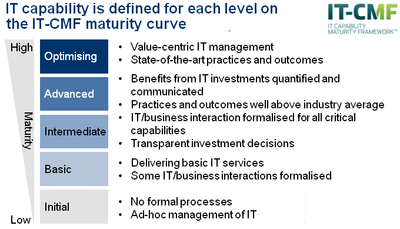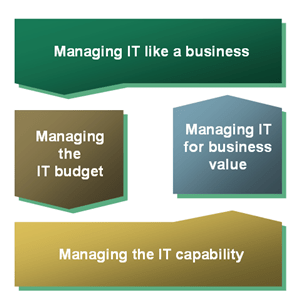IT Capability Maturity Framework (IT-CMF)
The IT Capability Maturity Framework (IT-CMF) is a model that evaluates and improves an enterprise’s information technology (IT) capabilities. It is designed to derive greater business value from IT.[1]
The origins of IT-CMF can be traced back to when Intel IT undertook a transformation to quantify and demonstrate the true value impact of IT. Professor Martin Curley, Vice President and Director of Intel Labs Europe, captured many of those approaches in his book 'Managing IT for Business Value' (2004), along with case studies from industry peers, which resulted in the IT Capability Maturity Framework (IT-CMF). Since then, the Innovation Value Institute (IVI) has been steadily developing this original work with further research on additional best practices, organizational assessment approaches and improvement roadmaps.
IT-CMF provides a toolset that contains maturity profiles, assessment methods and organizational improvement roadmaps; which collectively target improved delivery of value and innovation. The framework:
- Objectively identifies gaps in IT capabilities that are limiting IT performance and delivery of business value and innovation
- Contains standardized organizational assessment tools that allow organizations to benchmark themselves against similar organizations
- Defines a systematic structure to:
- implement best practice improvements in IT performance
- measure benefits over time[2]
Applying the IT-CMF Framework
Applying the IT-CMF Framework[3]
Using the IT-CMF as a guide, CIOs can help their IT organizations move from being perceived like a utility or technology supplier to become a core competency of the firm. They can help the organization move from a scenario where the IT budget is apparently out of control to where there is a sustainable economic model for the IT budget where increasing dem and for IT is met, while avoiding a runaway budget. They can help the organization move from being barely able to compute the total cost of ownership (TCO) of their infrastructure to being able to deliver and demonstrate optimized value from IT investments. The framework can help the IT organization move from being perceived as a cost center to that of a value center with a high level of IT and business alignment. Ultimately the goal of management (Salm an et at, 2005) is to create conditions of sustainability, controllability and predictability of the IT Capability in support of continuous value creation and use of the framework can support this goal.
IT-CMF Maturity Levels
IT-CMF Maturity Levels[4]
The IT-CMF is about achieving incremental improvements in IT maturity across the four macro capabilities based on a blueprint called the five-level maturity curve.

source: ICS
The Architecture of IT-CMF
The Architecture of IT-CMF[5]
IT-CMF is structured around four macro-capabilities, each of which embraces a number of critical capabilities (CCs) that can contribute to agility, innovation and value. At the top level, IT-CMF is structured around four key strategic areas, or macro-capabilities, for the management of IT
- Managing IT like a Business: To optimize the contribution of technology to the organization as a whole, the IT function needs to be managed using professional business practices. This involves shifting the focus away from technology as an end in itself towards the customers and the business problems to which IT can provide solutions. The Managing IT Like a Business macro-capability provides a structure within which the IT function can be repositioned from a cost center to a value center.
- Managing the IT Budget: There are many challenges associated with managing the IT budget, including, for example, unplanned cost escalation, the cost of maintaining legacy systems, and management reluctance to invest strategically in new technologies. The Managing the IT Budget macro capability looks at the practices and tools that can be used to establish and control a sustainable economic funding model for IT services and solutions.
- Managing the IT capability: The IT function was traditionally seen as the provider of one-off IT services and solutions. In order to fulfil its role as the instigator of innovation and continual business improvement however, the IT function has to proactively deliver – and be seen to deliver – a stream of new and improved IT services and solutions. This macro-capability provides a systematic approach to adopting that role, by effectively and efficiently maintaining existing services and solutions and developing new ones.
- Managing IT for Business Value: Investments in IT must be linked to overall business benefits. This means that the investments should not be viewed simply as technology projects, but as projects that generate business value and innovation across the organization. The Managing IT for Business Value macro-capability provides a structure within which the IT function provides the rationale for investment in IT and measures the business benefits accruing from it.
Together these four macro-capabilities operate in a continuous feedback loop to optimize the way in which IT is managed.
- Managing IT like a Business sets the direction for the overall IT Capability.
- In Managing the IT Budget, the strategic direction is translated into an IT budget to fuel activities and programs.
- Managing the IT Capability is the production engine, where two primary activities are performed: maintaining existing IT services and developing new IT solutions.
- Managing IT for Business Value ensures that these activities and programs deliver value.
The 36 Critical Capabilities of IT-CMF
The 36 Critical Capabilities of IT-CMF[6]
IT-CMF classifies 36 basic capabilities (see figure below) within these four macro-capabilities mentioned above, including all IT department roles. An enterprise’s key maturity issues and value-creation potential are revealed via the evaluation of an IT company’s maturity based on these 36 procedures, in addition to industry benchmark and best practice comparisons. For each capability, IT-CMF incorporates a comprehensive suite of maturity profiles, assessment methods, and improvement roadmaps – these are expressed in business language that can be used to guide discussions on setting goals and evaluating performance.

source: IVI
Benefits of IT-CMF
Benefits of IT-CMF[7]
IT-CMF has been used by a variety of global organizations to solve a range of capability issues. Whatever the priority issue, the IT-CMF enables assessment of current IT Capability gaps and helps to define a roadmap to achieve improved capability maturity with the KPI's and processes to track progress.
- IT capability measurement and improvement: Determine current capability through assessment, and plan to improve.
- IT organizational design and capability management: Design the roles and responsibilities of IT management based on critical capability distribution.
- IT business alignment and leadership: Better alignment and understanding between business and IT needs, improving leadership, governance, accountability and transparency.
- Organization benchmarking and best practice: Structure comparative qualitative and quantitative benchmarking with similar businesses.
- IT risk management: Clustered and 'deep dive' capability assessments to evaluate maturity and to target appropriate best practice.
- Cloud computing (including services innovation and outsourcing): Cluster the critical capabilities as appropriate to the organization's priorities and areas for improvement.
See Also
References
- ↑ Defining the IT Capability Maturity Framework (IT-CMF) Techopedia
- ↑ What is IT Capability Maturity Framework (IT-CMF)? ivi.ie
- ↑ Applying the IT-CMF Framework Martin Curley
- ↑ IT-CMF Maturity Levels ICS
- ↑ The Architecture of IT-CMF Vanharen
- ↑ The 36 Critical Capabilities of IT-CMF IVI
- ↑ How will my organization benefit from IT-CMF? ics-skills.ie
Further Reading
- The IT-CMF: A Practical Application of Design Science -Brian Donnellan, Markus Helfert
- Using the IT-CMF as an Enabler for Transformational Change -McLaughlin, Stephen
- SME innovation and differentiation as a business strategic priority – leveraging the SME IT-Capability Maturity Framework -Carcary, Marian

